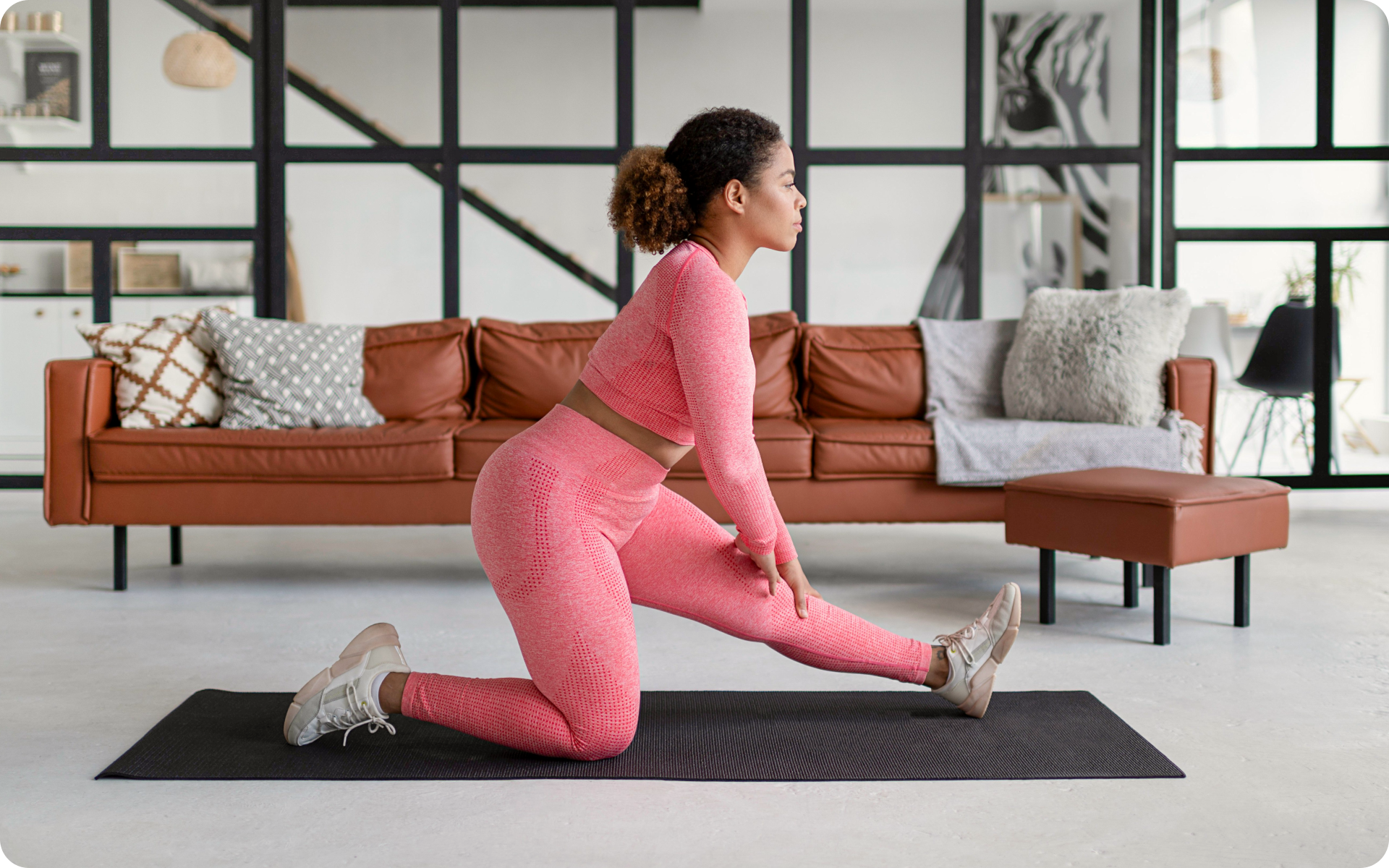If you’re new to strength training and you want to build muscles, you may be faced with a dilemma. Fat loss can energize you to take on harder workouts and build muscle. Conversely, muscle building can boost your metabolism to make you burn fat faster. So, which should you focus on first, fat loss or muscle-building?
There is no correct answer to this question. Expert opinions differ, and it comes down to what your personal fitness goals are. If you’ve been wondering “Should I lose weight before building muscle?” here’s everything you need to know to make a decision.
Pros of Focusing on Fat Loss First
If you’re trying to build muscle and you have a high body fat percentage, focusing on burning fat first will have the following benefits:
Weight Loss
Creating a consistent calorie deficit results in weight loss (13). This can increase motivation to exercise by increasing self-esteem and help you see your muscle definition more clearly.
When you focus on building muscle first, you may initially gain weight. Gaining weight while working out can be discouraging and may even make you want to quit your healthy eating and exercise plan.
More Energy
When your body is using fat for fuel instead of dietary carbohydrates or glycogen, you may feel like you have more energy (33). You’ll then be able to train harder without feeling tired.
Reduced Stress on the Joints
Being overweight or obese places significant stress on your joints (20). This may change how frequently you train or how hard you’re able to train. Losing weight first can make you more agile and capable to put in the effort at the gym and build muscle.
Faster Visible Results
Losing weight shows results faster than building muscle, which tends to be a long process. When you lose fat, you reveal your muscles, which you can focus on refining. Furthermore, quick results keep you motivated enough to continue the journey and sculpt your body.
Hormonal Balance
Hormones play a crucial role in muscle building. Unfortunately, excess fat can result in a hormonal imbalance (12). Achieving a healthy weight regulates your hormones and prepares your body for the muscle-building process that will come after.
BetterMe is your fast-track ticket to a long-lasting weight loss! Tailor your fitness journey and maximize your results with just a couple of swipes!
Pros of Focusing on Muscle Building First
To build muscle, you need to create a calorie surplus (18). For people who are new to fitness, the idea of eating more may seem counterintuitive. The initial weight gain that comes with muscle-building may discourage some people and make them give up on their journey to a better body. However, there are some benefits of focusing on muscle-building right off the bat.
Increased Metabolism
Studies have shown that when you build muscle, you increase your resting metabolic rate (16). This basically means that even while you’re not training, your body is burning more calories. Ultimately, you’ll burn fat and have a better body composition
Prevents Muscle Catabolism
When a calorie deficit is created, especially for extended periods of time, the body needs to look elsewhere for fuel. It can start to break down muscle for amino acids and convert them into energy. However, this will slow down your body’s ability to burn fat. Your body can also lose some of the enzymes responsible for breaking down carbohydrates if you don’t eat enough food or carbohydrate-rich foods.
Muscle catabolism is quite common for people who diet solely to lose weight (25). It’s basically the wasting away of lean muscle and it can affect your overall strength and appearance. Therefore, adding a strength training routine to a diet can have beneficial outcomes.
Can I Build Muscle and Lose Fat at the Same Time?
The two aims of weight training and physical conditioning are to increase muscle mass while reducing body fat—a process that is known as body recomposition. On the other hand, your body fights to perform both at the same time as they’re conflicting physiological processes.
You must have a well-documented strategy to maintain or improve your muscle size and reduce fat at the same time. Here are some tips for success:
Keep Your Caloric Deficit Small
To gain muscle, you need a calorie surplus. To lose weight, you need a calorie deficit. To do both, you’ll have to find a middle ground between being in a deficit and a surplus.
Research has shown that you can build substantial muscle by keeping a very small caloric deficit (22). Aim to cut out only 500 calories a day, and reduce this deficit even further to make greater muscle gains.
Read more: Should I Lose Weight Before Building Muscle? How To Strike a Balance And Achieve Your Body Goals
Do Compound Strength Exercise Three Times a Week
Lifting heavy weights doesn’t just help you lose weight, it also helps you keep your weight off. If you lift heavy weights for 20 to 30 minutes every two or three days, major muscle groups will be recruited and toned to help you burn fat faster.
Be Patient
You won’t see a big change overnight, but as you get closer to your goal, it will start to move slower. To build muscle and lose fat at the same time, be patient with your body.
Eat More Than 25 Grams of Protein Four Times a Day
In order for protein synthesis—the process that builds muscle—to occur, your body requires more than just protein. Ingesting at least 25 grams of protein at each meal is essential for building muscle and strengthening bones (6). It’s also helpful to eat small portions five or six times a day to fuel your muscles throughout the day and prevent over-eating later on.
Use Cardio for Recovery
Although it’s the best way to lose body fat, cardio isn’t the most effective way to build (or maintain) muscle when you’re in a caloric deficit. However, it’s a great way to recover from strength training workouts and maintain your muscles. Cardio exercises such as walking, cycling, or swimming increase blood flow through the body and supply your cells with blood and nutrients.
Be Aware of Your Caloric Intake
You need to be aware of how many calories you consume every day. Keep track of all the food you eat for a few days so you can get an idea of what exactly is going into your body and how it affects your weight loss goals (7). If necessary, you can lower your caloric intake accordingly so your goal is easier to accomplish. Usually, watching what you eat is the best way to burn fat.
One of the ways to simplify the process is to use apps for calorie tracking. BetterMe: Health Coaching offers a meal tracker and a water tracker for your convenience!
Do HIIT In Moderation
High-intensity interval training can be a great way to lose weight and build muscle (14). However, it’s important to do cardio in moderation as if you perform too much of it, you could end up losing lean muscle mass, which will severely affect your ability to burn fat and keep the weight off.
We’ve discussed how to incorporate planks in a HIIT routine in our 30-Day Plank Challenge For Beginners article.
How to Speed up Muscle Growth
Speeding up muscle growth requires a combination of proper nutrition, a well-designed workout routine, and sufficient rest and recovery. In addition to these basics, there are some key strategies that can help you maximize your results and achieve your muscle growth goals faster.
1. Increase Training Volume
Increasing the amount of weight you lift and the number of sets and repetitions can stimulate muscle hypertrophy. More volume means your muscles work harder and longer, which encourages them to adapt and grow stronger over time (26).
2. Focus on Eccentric Training
Emphasize the eccentric (lowering) phase of your lifts, which has been shown to cause more muscle damage and subsequently greater muscle growth. The eccentric phase is when your muscles are lengthening under tension, creating micro-tears that lead to increased muscle mass when repaired(30).
3. Shorten Rest Intervals
Reducing rest periods between sets to 30-60 seconds can increase muscle endurance and growth by keeping the muscles under tension for longer periods. Shorter rest intervals force your muscles to recover faster, which can enhance muscle endurance and size (rest).
4. Lift Heavier Weights
Progressively lifting heavier weights forces your muscles to adapt and grow stronger. This principle, which is known as progressive overload, is essential for continuous muscle growth. Gradually increasing the weight trains your muscles to handle more stress, which leads to hypertrophy (21).
5. Perform Compound Exercises
Exercises such as squats, deadlifts, and bench presses engage multiple muscle groups simultaneously, which leads to more overall muscle development. Compound movements are efficient as they stimulate high levels of muscle activation and can help build strength and size across various parts of the body (34).
Find detailed compound exercises you can try in our Compound Exercises For Weight Loss blog.
6. Increase Training Frequency
Training each muscle group more frequently, such as 2-3 times per week, can lead to faster gains compared to a once-a-week regimen (17). More frequent stimulation keeps muscles in a constant state of growth and repair, which reduces the risk of hitting a plateau.
7. Consume More Protein
Protein is essential for muscle repair and growth. Aim for 1.6 to 2.2 grams of protein per kilogram of body weight per day. High-protein foods provide the building blocks (amino acids) necessary for repairing muscle tissue damaged during workouts (6).
8. Optimize Your Nutrition
In addition to protein, ensure you’re consuming enough calories, carbohydrates, and healthy fats to fuel your workouts and recovery. A well-rounded diet supports overall energy levels, muscle repair, and growth, helping you achieve your fitness goals more effectively (10).
9. Get Adequate Sleep and Rest
Muscles grow during rest, not just in the gym. You should aim for 7-9 hours of sleep per night and include rest days in your training regimen to allow for recovery. During sleep, your body releases growth hormones and repairs muscle tissue, making it essential for muscle growth and overall health (23).
If you’ve mustered up the courage to crush your weight loss goal, let Betterme take the sting out of this demanding process. Our app will help you restructure your habits, remold your life and crank up your fitness results!
Meal Plan for Weight Loss and Muscle Gain
Losing weight and gaining muscle don’t have to be mutually exclusive as both are necessary for long-term weight loss and lifelong health and fitness. You can achieve both goals simultaneously by following a fitness and nutrition plan that is suited for you. Here are the foods you should include in your diet for muscle gain, and some you should avoid.
Lean Protein
There are several reasons why a high-protein diet is essential for body recomposition. When you eat enough protein throughout the day, your body can maintain muscle mass by naturally suppressing appetite and regulating metabolism. Furthermore, protein contributes to greater satiety and helps you feel full longer (32).
Some ideal proteins to include in your body recomposition diet are:
- Lean red meat and poultry
- Eggs
- Tuna or other fish
Complex Carbohydrates
Carbohydrates are the body’s main source of energy (4). When you work out, your muscles rely heavily on carbohydrates for fuel. Without these carbohydrates, your body will be depleted of energy and less likely to build muscle mass.
A healthy balance of carbohydrates helps optimize fat loss and prevents a calorie deficit from turning into muscle loss. Ideal sources of whole carbohydrates include:
- Oatmeal
- Brown rice
- Quinoa
Healthy Fats
Fats have gotten a bad reputation as being harmful to heart health and increasing cholesterol levels. However, healthy fats are essential for a balanced diet for their nutrients and for regulating hormones that play a significant role in weight management, such as insulin.
Some healthy fats are anti-inflammatory, which means they reduce inflammation in the body, thereby reducing the risk of certain chronic diseases such as obesity, diabetes, and autoimmune diseases. Healthy fats also provide essential fatty acids that help regulate fat storage in the body (1).
Good sources of healthy fats include:
- Olive oil
- Avocado
- Nuts and nut butters
- Fish oils
Foods to Avoid to Lose Weight and Build Muscle
In order to achieve your body recomposition goals, you’ll need to eliminate these foods from your diet:
Refined Carbohydrates
Refined carbohydrates (including white bread and pasta) can prevent weight loss and muscle gain. Refined carbs spike blood sugar levels, which leads to increased insulin production (4).
Insulin regulates fat storage in the body by telling your cells that they’re not experiencing a calorie deficit and don’t need to burn energy sources such as fat.
Simple sugars such as those that are found in refined carbs don’t provide any nutrients necessary for building muscle mass or losing fat. You’ll also feel hungry shortly after eating them because foods that are high in simple sugars make you quickly lose blood sugar, which leaves you feeling ravenous shortly after meals.
Artificial Sweeteners
Artificial sweeteners are not the answer to weight loss. They are so chemically engineered that the body doesn’t recognize them, potentially causing sugar cravings and unhealthy metabolic changes.
Artificial sweeteners may cause you to crave more sweets during the day while actually increasing your appetite for other foods. Some of them may even affect insulin secretion, which could lead to an increase in visceral fat (belly fat) and slowed metabolism over time (31).
High-Fructose Corn Syrup
As with refined carbohydrates, high-fructose corn syrup is often used to cut calories while maintaining flavor. However, as with artificial sweeteners, fructose causes blood sugar levels to spike rapidly before dropping significantly, which can lead to food cravings throughout the day and increase your risk of chronic disease. In addition, excess fructose promotes insulin resistance and visceral fat (5).
Saturated Fat
Although it’s found naturally in some foods, the majority of saturated fat comes from hydrogenated or partially hydrogenated oils in processed foods. Unlike healthy fats that help regulate hormones and metabolism, saturated fat in excess is harmful to your health (27).
Diet Soda
This beverage is often used as a substitute for regular soda, but it can actually do more harm than good when consumed frequently. Diet soda contains no calories, a fact that may lead you to believe it’s a better choice than regular soda.
However, it is primarily made of chemicals and artificial sweeteners that may actually lead to weight gain and increased risk of chronic disease (28).
Diet soda has been shown to increase the risk of obesity and type 2 diabetes. People who drink two or more diet sodas per day have a greater chance of developing metabolic syndrome than those who consume less, according to one study (8).
In addition, research published in the Journal of General Internal Medicine found the daily consumption of artificially-sweetened beverages to be associated with a higher risk of stroke and heart attack compared to drinking them only once weekly or not at all (9).
Hard Alcohol
While alcohol provides calories (7 kcal/gram), drinking too much can interfere with your workout. Heavy alcohol consumption affects testosterone production, which is essential for maintaining muscle mass and building lean tissue (11). In addition, alcoholic beverages are high in empty calories that don’t provide any necessary nutrients to build or maintain muscle or burn fat.
Read more: The 6 Day Workout Split for Building Muscle and Strength
FAQs
How long does it take to turn fat into muscle?
Turning fat into muscle is physiologically impossible as muscle and fat are composed of different types of cells. However, you can reduce fat while building muscle through a combination of diet and exercise.
Noticeable changes in body composition typically occur within three to six months. This process, which is known as body recomposition, requires a calorie deficit to lose fat and sufficient protein intake to build muscle (3).
The scale may not reflect immediate changes, as muscle is denser than fat and can result in a minimal change in weight. Instead, pay attention to changes in body measurements and how your clothes fit.
Can you intermittent fast and still gain muscle?
Yes, it’s possible to gain muscle while practicing intermittent fasting (29), although it requires careful planning and adherence to certain guidelines.
- Caloric Intake: Ensure you’re consuming enough calories to support muscle growth. Even though your eating window is restricted, you need to obtain sufficient macronutrients—proteins, carbohydrates, and fats—within that period.
- Protein Consumption: Protein is essential for muscle repair and growth. Aim for a high protein intake during your eating window to meet your daily requirements. This typically ranges from 1.6 to 2.2 grams of protein per kilogram of body weight.
- Nutrient Timing: Pay attention to nutrient timing by consuming protein-rich meals both at the start and the end of your eating window to maximize muscle protein synthesis.
- Training: Maintain a regular strength training routine. Focus on progressive overload, where you gradually increase the weight or resistance in your exercises to continually challenge your muscles.
- Recovery: Ensure adequate recovery time between workouts and get sufficient sleep to support muscle repair and growth.
- Hydration: Stay well-hydrated throughout the day, particularly during your fasting period, to support overall health and performance.
- Supplements: Consider supplements such as branched-chain amino acids (BCAAs) or protein powders to help meet your nutrient needs (19), but prioritize whole foods whenever possible.
Find more information in our Should I Workout On An Empty Stomach article.
What is the ideal body fat for building muscle?
The ideal body fat percentage for building muscle varies. For men, an effective range to optimize muscle growth is typically between 10-20% body fat, while it is around 20-30% body fat for women (15). These ranges help maintain a balance where you’re not too lean (which could impact hormone levels and recovery), but also not carrying excessive fat that may hinder muscle definition.
Some experts recommend leaning out to around 10-12% body fat for men (or slightly higher for women) before starting a bulking phase (15). This approach helps reduce the risk of gaining excessive fat during the muscle-building process.
It is suggested that you stop bulking when body fat reaches around 15% for men in order to avoid unnecessary fat gain. This helps ensure that muscle gains are more pronounced and less fat is gained.
It’s important to consider personal health and comfort levels. Everyone’s body responds differently to diet and exercise, so finding a balance that suits your lifestyle and goals is very important.
Do bodybuilders ever do keto?
Yes, bodybuilders sometimes follow a ketogenic (keto) diet. The keto diet is a high-fat, low-carbohydrate diet that forces the body to burn fats rather than carbohydrates for energy, which leads to a state called ketosis. Here’s how it can be beneficial for bodybuilders (2):
- Fat Loss: The primary advantage of the keto diet is rapid fat loss, which can help bodybuilders achieve a leaner physique.
- Muscle Preservation: While on keto, the body burns fat for energy and preserves muscle tissue, which is essential for bodybuilders.
- Stable Energy Levels: Instead of relying on carbohydrates for quick bursts of energy, keto provides steady energy from fats, which can enhance endurance during workouts.
- Reduced Inflammation: High-fat diets can help reduce inflammation, which may improve recovery times and reduce muscle soreness.
- Appetite Control: High-fat foods are very satiating, which can help bodybuilders manage their appetite and caloric intake more effectively.
That being said, there are also some potential downsides to consider (2):
- Adaptation Period: Transitioning to a keto diet can lead to initial side effects often referred to as the “keto flu”, including fatigue, headaches, and irritability.
- Performance Impact: Some bodybuilders have reported reduced performance in high-intensity workouts due to the low carbohydrate intake.
- Diet Complexity: Planning and maintaining a keto diet can be complex and requires careful management of macronutrient ratios.
- Nutrient Deficiencies: Without careful planning, it can be easy to miss out on essential nutrients that are typically found in carbohydrate-rich foods.
The above challenges can be overcome with proper planning and monitoring and here are some tips to help with that:
- Gradual Transition: Slowly reduce your carbohydrate intake while increasing fat consumption to ease the body into ketosis.
- Quality Fats: Focus on healthy fats such as avocados, nuts, seeds, and olive oil rather than processed fats.
- Protein Intake: Ensure adequate protein intake to support muscle maintenance and growth.
- Electrolytes: Supplement with electrolytes such as sodium, potassium, and magnesium to avoid imbalances.
- Monitor Progress: Regularly track your physical performance, body composition, and overall health to ensure your diet meets your needs.
The Bottom Line
You don’t need to choose between building muscle and losing weight. If you focus on less cardio, eat more protein, do compound strength exercises, track your food intake, and take a break from your diet every once in a while, you’ll build muscle and lose fat at the same time.
DISCLAIMER:
This article is intended for general informational purposes only and does not serve to address individual circumstances. It is not a substitute for professional advice or help and should not be relied on for making any kind of decision-making. Any action taken as a direct or indirect result of the information in this article is entirely at your own risk and is your sole responsibility.
BetterMe, its content staff, and its medical advisors accept no responsibility for inaccuracies, errors, misstatements, inconsistencies, or omissions and specifically disclaim any liability, loss or risk, personal, professional or otherwise, which may be incurred as a consequence, directly or indirectly, of the use and/or application of any content.
You should always seek the advice of your physician or other qualified health provider with any questions you may have regarding a medical condition or your specific situation. Never disregard professional medical advice or delay seeking it because of BetterMe content. If you suspect or think you may have a medical emergency, call your doctor.
SOURCES:
- A healthy approach to dietary fats: understanding the science and taking action to reduce consumer confusion (2011, ncbi.nlm.nih.gov)
- Advantages and Disadvantages of the Ketogenic Diet: A Review Article (2020,nih.gov)
- Body Recomposition: Can Trained Individuals Build Muscle and Lose Fat at the Same Time? (2020,journals.lww.com)
- Carbohydrates and Blood Sugar | The Nutrition Source | Harvard TH Chan School of Public Health (n.d., hsph.harvard.edu)
- Consuming fructose-sweetened, not glucose-sweetened, beverages increases visceral adiposity and lipids and decreases insulin sensitivity in overweight/obese humans (2009, jci.org)
- Dietary Protein and Muscle Mass: Translating Science to Application and Health Benefit (2019, ncbi.nlm.nih.gov)
- Dietary Self-Monitoring Through Calorie Tracking but Not Through a Digital Photography App Is Associated with Significant Weight Loss: The 2SMART Pilot Study-A 6-Month Randomized Trial (2019, pubmed.ncbi.nlm.nih.gov)
- Diet Soda Intake and Risk of Incident Metabolic Syndrome and Type 2 Diabetes in the Multi-Ethnic Study of Atherosclerosis (MESA) (2009, ncbi.nlm.nih.gov)
- Diet Soft Drink Consumption is Associated with an Increased Risk of Vascular Events in the Northern Manhattan Study (2012, ncbi.nlm.nih.gov)
- Editorial: Nutritional Strategies to Promote Muscle Mass and Function Across the Health Span (2020,nih.gov)
- Effects of Alcohol on the Endocrine System (2013, ncbi.nlm.nih.gov)
- Endocrine Changes in Obesity – Endotext – NCBI Bookshelf (2017, ncbi.nlm.nih.gov)
- Fat Loss Depends on Energy Deficit Only, Independently of the Method for Weight Loss (2007, karger.com)
- High-Intensity Intermittent Exercise and Fat Loss (2011, ncbi.nlm.nih.gov)
- Indicators of Health: Body Mass Index, Body Fat Content, and Fat Distribution (n,d,hawaii.edu)
- Increasing muscle mass to improve metabolism (2013, ncbi.nlm.nih.gov)
- Maximizing Muscle Hypertrophy: A Systematic Review of Advanced Resistance Training Techniques and Methods (2019,nih.gov)
- Nutrition Recommendations for Bodybuilders in the Off-Season: A Narrative Review (2019, ncbi.nlm.nih.gov)
- Nutritional supplements to increase muscle mass (1999,nih.gov)
- Obesity & osteoarthritis (2013, ncbi.nlm.nih.gov)
- Progression of volume load and muscular adaptation during resistance exercise (2014,nih.gov)
- Recent Advances in the Characterization of Skeletal Muscle and Whole-Body Protein Responses to Dietary Protein and Exercise during Negative Energy Balance (2019, ncbi.nlm.nih.gov)
- Relationship between sleep and muscle strength among Chinese university students: a cross-sectional study (2017,nih.gov)
- Rest interval between sets in strength training (2019,nih.gov)
- Regulation of skeletal muscle protein metabolism in catabolic states (2005, pubmed.ncbi.nlm.nih.gov)
- Resistance Training Volume Enhances Muscle Hypertrophy but Not Strength in Trained Men (2019,nih.gov)
- Saturated Fat: Part of a Healthy Diet (pubmed.ncbi.nlm.nih.gov)
- Sugar substitutes: Health controversy over perceived benefits (2011, ncbi.nlm.nih.gov)
- The Effects of Intermittent Fasting Combined with Resistance Training on Lean Body Mass: A Systematic Review of Human Studies (2020,nih.gov)
- The Health and Functional Benefits of Eccentric versus Concentric Exercise Training: A Systematic Review and Meta-Analysis (2023,nih.gov)
- The Impact of Artificial Sweeteners on Body Weight Control and Glucose Homeostasis (2021, frontiersin.org)
- The role of protein in weight loss and maintenance (2015, pubmed.ncbi.nlm.nih.gov)
- Use and storage of carbohydrate and fat | The American Journal of Clinical Nutrition | Oxford Academic (1995, academic.oup.com)
- WHAT ARE COMPOUND EXERCISES? (2024,fitnesseducation.edu.au)















